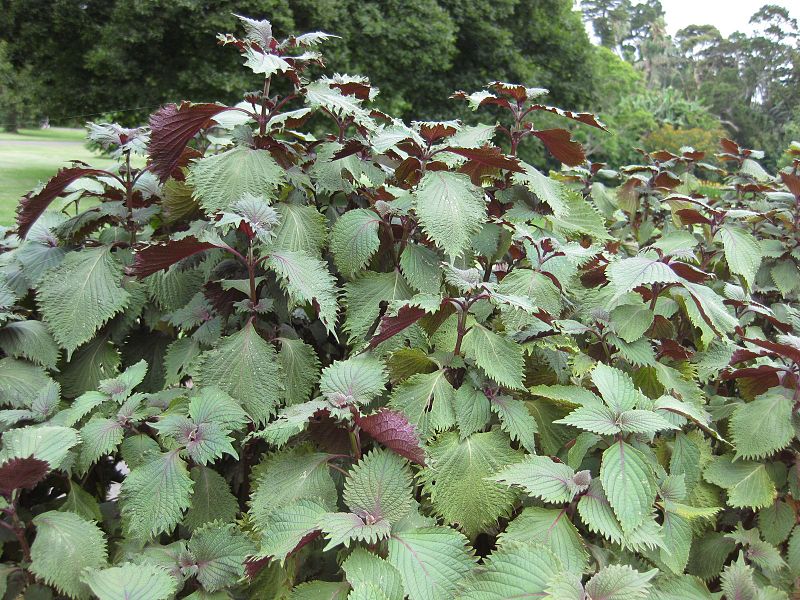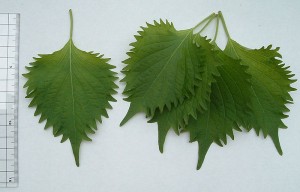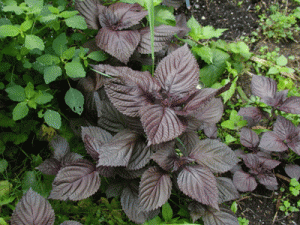The first Perilla I ever had came from a can, just like the kind sardines snuggle in. The leaves were very spicy and were used that way, as a spice. Later in my garden I grew the plant, which reseeded itself. That’s probably why Perilla is naturalized in the eastern half of North America excluding Vermont, New Hampshire, Maine and Canadian points north and east. Its native land is India.
Strictly speaking Perilla is a monotypic genus. (See article on monotypic genus.) There is only one species in the genus, but three are varieties. There are two major forms of cultivated Perilla, green and red though green is the most common escapee I have seen. Those common names are slightly misleading. The “Green” version is green on top of the leaf, and purple below. The “red” version has leaves that are purplish on top and bottom.
Perilla has been used as a salad ingredient, potherb and for its seed oil for literally thousands of years. And while the seed oil is edible — up to 64% Omega 3 fatty acids — it may not be the best oil to cook with. The oil, similar to unrefined Canola oil, has a chemical that is a potential lung toxin. The oil also has been used for lamps, which might be a dangerous use regarding potential lung damage. (Unrefined Canolia oil — rape seed oil — was used for cooking in India and a common cause of lung problems.)
According to the Federal Department of Agriculture Perilla has three chemical that are known lung toxin to cattle; egomaketone, isoegomaketone, and perilla ketone, the latter the most abundant and worse. Tests show Perillla ketone also produced pulmonary emphysema in goats, mice and rats. It does horses as well. While humans eat the species with little issue it is best to use any seed oil cold not heated.
In the greater mint family, noses and palettes disagree on what Perilla tastes and smells like, from cinnamon to licorice. I lean towards spicy cinnamon. It has numerous common names, among them Ao Shiso, Beefsteak Plant, Ji Soo, Perilla, Purple Perilla, Shiso, Wild basil, Wild Red Basil, Chinese Basil, Purple Mint, Rattlesnake Weed, Summer Coleus and Perilla Mint. In some individuals the plant can cause dermatitis.
Why the genus was called Perilla by the Latin scholar Linnaeus is debatable. It could mean “little bag” referencing the caylex. Despite what Internet “Baby Name” sites say Perilla (per-RILL-ah) is not an American invention, though it was a common girl’s name in the 1800s in the United States. Perilla was the nick name of Caecillia Metella the poetess, and lover of the Ancient Roman poet Ticida, and many others. Ticida (probably Clodius Aesopus) was not political but besides writing poetry he provided supplies to Julius Caesar’s army in 46 BC. Caecillia also seduced several of Julius Caesar’s intimate friends and was involved in much political scandal and intrigue. Soon married and divorced Caecillia was a talented, savvy, good looking party girl who probably wrote erotic poetry and is also called Lesbia in other poems. We know that Ticida invented the name “Perilla” for her by using Greek word play on her family name Metella. When she died we do not know. Thus what was a common proper name in the 1800s for girls in America was at its invention used to protect the public identity of a woman who wrote racy erotic poetry and slept around. And perhaps that is why the species is called Perilla, it’s attractive, spicy, and gets around. Frutescens (frew-TESS-enz) means shrubby or bushy.
Green Deane’s “Itemized” Plant Profile: Perilla
IDENTIFICATION: Perilla frutescens: Stems to a yard high, erect, herbaceous, purple, four-angled, a single vertical groove on each side of the stem. Leaves are opposite, petiolate, purple with a very shallow groove. Blades ovate, serrate, acute, to four inches long (10cm) three inches wide (8cm) sometimes crisped (curled or undulated) or not, typically green above and purple-green or entirely purple below, mostly hairless above, hairy on the veins below. Flower spikes growing out of where a leaf stem meets a main stem or at the top end of the plant. Blossoms pink, four stamens, anthers pinkish, fading to purple, two blossoms per node, each with a folded bract. Bracts broadly ovate when unfolded.
TIME OF YEAR: Flowering August to October.
ENVIRONMENT: Gravel bars, rich soils, alluvial soils or dry soils along streams, spring branches, gravel bars, roadsides, railroads.
METHOD OF PREPARATION: Leaves used as a coloring or a spice. Flower spikes in soup or fried. Seeds uses as a spice or a source of edible oil. Sprouts cooked and eaten like a potherb.





I’m in Ft. Lauderdale FL, are these fellows around me, Deane? They seem rather familiar, if not only from plant nurseries. Sure is a pretty plant.
Usually they are escaped from cultivation, so they could be…
Are these poison to dogs? Also it’s August and I’m 100% positive my plant is purple perilla, But has no stoman yet ,is that an autumn thing or is mine just too close together in clusters to grow above 8″?
Love the info about the names! Purple Perilla can make a gorgeous container plant, but be aware that it spreads from seeds everywhere.
I found this plant here in the Ozarks last fall and collected some seeds. I didn’t know what the plant was but I grew it and asked around until I found an answer. After doing a lot of research on this plant I found that only the wild Perilla that grows in the U.S. has the lung toxin, Perilla ketone. I didn’t know about this toxin untul one day after eating a few leaves. It wasn’t a bad experience, just unpleasant. This toxin may have came about from basic survival of the plant here in the United States. The varieties from China, Japan, and Korea don’t have this toxin. This plant is the perfect replacement for fish oil.
Robert, do u have the image for the wild Perilla. I grow Purple Perilla given by a friend. I don’t know where she got it from. Just want to make sure that it is not the toxic Perilla. Thanks.
I’m confused; please cite sources indicating toxicity difference between wild Perilla & varieties from China, Japan, and Korea. Is there any way to differentiate?
Please, please do not introduce this highly toxic plant to Vermont. It kills sheep cattle and horses with an agonizing death by flooding the lungs with fluid — slow drowning. This plant spreads rapidly and originally came from the Far East. Currently it is the most common plant poisoning in the southeast U.S. One irresponsible importer can but many animals at risk We need to be responsible and not introduce harmful invasive plants.
That is mentioned in the article.
Good thing I’m in the middle of Houston and have them in a contained flower bed. I can see how it could be devastating.
Are you aware of any toxicity difference between wild Perilla & varieties from China, Japan, and Korea?
I am very concerned as I have found a patch in my horse pasture; I have pulled all that I saw but I’m sure there will be some remaining.
I just made Perilla tea from green leaves. I’ve seen the stuff in the Japanese grocery by me and it grows in abundance around Georgia. Now I am wondering how I can tell which has escaped cultivation and which is wild. Yikes!
How do I get rid of this? It’s taking over my flower beds.
Eat it?
I got bought 3 small plants at a yard sale about 3 yrs ago, Planted it and I now have a mini farm filled with healthy Green Ao Shiso, I have been using it ever since then raw and cooked. I puree about 5grams sieve and drink among my family at least every other day , tastes great as a drink especially when cold.. never experienced any side effects .. now in this autumn we also eat the fresh green crisp seeds (so delicious.! ) The Japanese use this type everyday in restaurants and home cuisine and since I do happen to know that they are extremely cautious about health and food , I am absolutely certain that this is good and healthy for our human consumption. sooo I will now recommend that this article if well understood tells us that it is good for our health ..With much gratitude to the Author.. God Bless
I’ve used the leaves for years as “wild basil” on speghetti…. No problems whatsoever with me or anyone I’ve served it too.
I’ve made tea with it, no problems.
Not sure why there is a poison issue???
There is always someone that is allergic to something others aren’t, like comfrey, but in general comfrey is a great herb to use too. So use your own judgement and common sense and eat a little or drink a little and see how it effects you…. These plants are here fro a reason. They aren’t here for nothing…. research. Thousands of years of native people have used herbs and weeds for many things. I’m sure some have died but many have lived and become happy, healthy and blessed by the plants on our Earth. Blessings
My residence is in S.W. Alabama and about 1/2 acre of my goat pasture is covered in healthy green perilla plants. The goats do not eat it as it is toxic to them. Each year I try to eliminate as many plants as I can by pulling them up by the roots. They are very prolific and consistently come back each year. My question is: would there be someone out there that could benefit from these plants by coming to this area and harvesting them free of charge?
Ask around any Asian, esp. Japanese restaurants. They love it.
Hi ,
Please find details as below
Here are the exact specifications of Perilla Leaves that
I am looking for:
A. Salted and fro
D. Scientific Name: Pezen perilla leaves
B. Package: 10kg, 20kg
C. Destination: Incheon Port, Korea
rilla Frutescens var Frutescens
E. Standard Processing Procedures: 1. Clean the perilla
leaves thoroughly with water and remove all the impurities
2. Soak the cleaned perilla leaves in a bowl of 20% salted
water (either refined salt or white salt) for 1 full day;
make sure the leaves are well soaked (use rock or heavy
items to press, if necessary) 3. Remove the soaked leaves
and clean them with fresh water again 4. Place the soaked
leaves in a refrigerated container and freeze at -18 Celsius
before loading.
F. Target Price: CIF Incheon / Busan USD 0.7 per kg
G. Order Quantity: 100 tons per month
Regards,
Debasish Chakraborty
That’s awesome. I hope you found someone who could have done that for you. If not. Eat them! Pretty good salad filler.
thats cool. i had seen them and thought they were coleus plants for years. interesting to find out they they are edible
I know this is an old article, but I was curious how “[w]e know that Ticida invented the name ‘Perilla’ for her by using Greek word play on her family name Metella.” Also, your ideas on how the new Latin Perilla was attached to this plant are pretty cool. Thanks for the research!
We have the plant and I am using it and tincturing it and my sister sent me an article how it is a invasive toxic plant killing cattle and I explained to her how it was both because they say it is toxic for animals but from what I’ve studied it’s very good for autoimmune
I’m interested in any resources you may know on autoimmune uses.
I have always loved the fragrance and just started using this as a tea. I am especially concerned regarding lung toxins.
Is there anyway to actually tell the difference between the Genus Coleus and Perilla. I really want to try eating Perilla but too bad since Coleus a near damn look alike also exist that is poisoness and hallucinogenic. I wish he clarified how to tell the difference since they look so so damn similar. I hope this isn’t true but Apparently both plants can hybridize making the plant both poisonous and edible? That would explain why they look so similar but that doesn’t give me confidence in foraging it since both plants can have green or purple color and any color in between, Both can have wavy leaves or straight leaves and all with toothed margin that ranges from bumpy to deep.
How can I guarantee that my Perilla doesn’t hybridize with my coleus so it doesn’t poison me?
Check this out here about the hybrid : https://davesgarden.com/guides/articles/view/2969/
Also here is the website confirming that Coleus is it’s own genus but doesn’t list any species (ODD?). But is this website wrong?
https://www.itis.gov/servlet/SingleRpt/SingleRpt?search_topic=TSN&search_value=32469#null
Or Is the Genus for Coleus Solenostemon? Same website says that name hasn’t been confirmed.
https://www.itis.gov/servlet/SingleRpt/SingleRpt?search_topic=TSN&search_value=500670#null
This website also tried to do the job of differentiating the two but still doesn’t give me confidence since there is nothing concrete just “tend to be’s” which is no good in 100% Correct Identification. It says flower structure is different but how?
https://www.illinoiswildflowers.info/weeds/plants/beefsteak.htm
Lastly I found this website which gives me some answers but leaves me with even more questions.
https://garden.org/ideas/view/rattlebox/2111/Perilla-Magilla-vs-Perilla-vs-Coleus/
It’s a curious issue. I raised coleus decades ago and I’ve also raised perilla. I never thought of them as closely related. That said m coleus was not at all aromatic or flavorful whereas my perillas was always spicy and of a pleasant aroma.